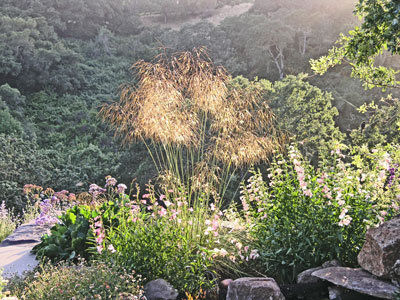
One of the most dramatic sights in a garden is an ornamental grass backlit by late-afternoon sun. They seem to come alive as their tawny flowers spikes glow and sway in the breeze.
This is what grasses are all about and why they are so popular. Who could resist?
Grasses are versatile plants that come in all sizes, from ground-huggers to shrub-like clumps. Some form upright tufts; some look like mop-top mounds; and others form arching fountains.
They easily adapt to the same conditions most garden plants thrive in, rarely needing any special soil, preparation or maintenance. More subtly, their gentle movement and soft whispering sounds can bring your garden to life as no other plants do.
Grasses serve many functions in a garden. If you want to replace your lawn and save water, you can choose from California natives. Some are low, like sesleria and Carex pansa, while others, like Festuca californica, make great flowering accents and look best massed in groups. Other good natives for meadows are blue grama (Boutelous gracilis), creeping wild rye (Leymus triticoidies) and alkali sacaton (Sporobolus airoides).
Both San Lorenzo Valley and Scotts Valley water districts (www.slvwd.com and www.svwd.org) offer many tips and incentives to conserve water. There are lists on their websites of water-smart grasses. Their rebate programs offer several landscaping credits, including converting an existing lawn to water-wise grasses. Both districts have guidelines and procedures to apply for the rebates on their websites.
My favorite shade-tolerant grass varieties for meadows are red fescue, sweetflag (Acorus gramineus), Festuca altissima, Bromus beneckenii and several varieties of Carex divulsa, blanda and texensis.
But it’s the showy accent grasses that always get my attention, and pink muhly grass (Muhlenbergia capillaris) has got to be at the top of the list. A must-have for the low-maintenance garden, this ultra-rugged, ultra-tough California native grass is topped in late summer and fall by enormous plumes of cotton-candy pink that can also be used in dried arrangements.
I like variegated plants and two-tone grasses that combine well with many other garden plants. Miscanthus sinensis “Morning Light” is an especially refined and elegant ornamental grass. Its fine leaf blades are green with clean, paper-thin, white margins that give the plant a silvery cast when viewed from a distance. It is luminous when backlit by the early-morning or late-afternoon sun. Morning Light tends to keep its upright shape better than some other cultivars and rarely flops. The reddish-bronze plumes that appear in late fall are spectacular.
Another personal favorite ornamental grass is giant feather grass (Stipa gigantea). This semi-evergreen grass grows 2 to 3 feet high and makes a stately specimen with narrow, arching foliage and shimmering gold panicles that reach 6 feet tall. The flowers open early in June as silvery-purple and mature to shades of wheat. Large plants in full flower are a spectacular sight. Their tufted, clumping form makes them suitable as accents anywhere. Giant feather grass can survive drought once established but also will grow with regular garden watering. The beautiful flower spikes are good in dried arrangements.
Caring for grasses is easy. As a rule of thumb, if it browns in winter, then cut it back before new growth starts. If it’s evergreen by nature, just clean up the outside leaves.
Most like well-drained soil and are tolerant of a wide range of garden conditions. You shouldn’t fertilize heavily, because an excess of nitrogen can lead to lush, soft growth that tends to flop. Mulching with 2 inches of compost yearly will keep the soil and your plants in good shape.
Water grasses regularly during their first year to get a good root system established. Even grasses that are touted as drought-tolerant require a season or two to become fully established.
– Jan Nelson, a landscape designer and California certified nursery professional, will answer questions about gardening in the Santa Cruz Mountains. Email her at ja******@*ol.com, or visit www.jannelsonlandscapedesign.com to view past columns and pictures.












